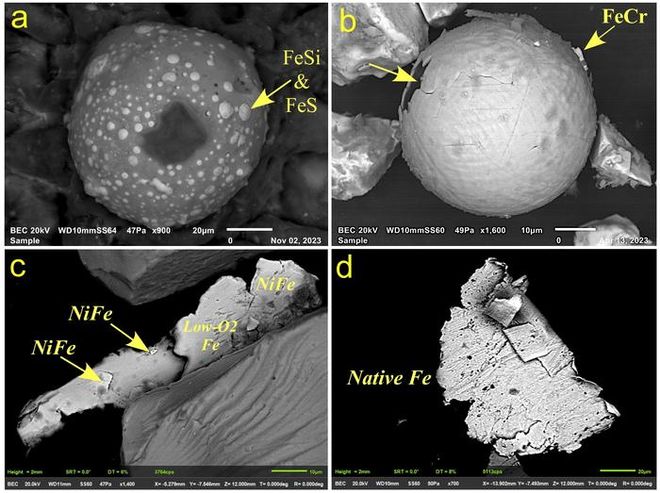Around 12,800 years ago, the Northern Hemisphere got cold — really cold — in an abrupt climate change crisis called the Younger Dryas event. Now, researchers have found evidence that suggests that the sudden catastrophe may have been caused by a comet.
Reporting their results in a study in PLOS One, the researchers identified geochemical signatures in deep-sea sediments from Baffin Bay, off the coast of Greenland, which indicate that the cooling of the Northern Hemisphere’s air and ocean may have come from a collision with a comet as it disintegrated.
“Collisions of the Earth with comets led to catastrophes, leading to climate change, to the death of civilizations. One of these events was a catastrophe that occurred about 12,800 years ago,” said Vladimir Tselmovich, a study author from the Russian Academy of Sciences, according to a press release. “Having studied in detail the microscopic traces of this disaster in Baffin Bay, we were able to find multiple traces of cometary matter.”
Disintegrating Comets and Climate Change

Examples of Fe-rich and silica-rich impact microspherules (a and b) and metallic dust particles (MDPs; c and d) interpreted as cometary dust from Baffin Bay cores. Yellow arrows show particles of FeSi, FeS, and FeCr on microspherules (a and b) and NiFe, low-O2 Fe, and native Fe on metallic particles (c and d). Note folded edges of MDP in panel d.
Moore et al., 2025, PLOS One, CC-BY 4.0 (https://creativecommons.org/licenses/by/4.0/)
Dropping around 10 degrees Celsius in the span of a single year, then stabilizing at a lower level for around 1,200 years, the temperatures of the Northern Hemisphere were abnormally cold throughout the course of the Younger Dryas, potentially prompting consequences for the plants, animals, and human civilizations that lived there. But whatever the consequences, their cause is typically attributed to an increase in glacial meltwater, which would have weakened the ocean currents that transport warm water throughout the Northern Hemisphere.
While some scientists suspect that this glacial meltwater arose without a comet, others say that one of these celestial ice clumps created the melt. Indeed, the proponents of the “Younger Dryas Impact Hypothesis” posit that the debris from a disintegrating comet destabilized Earth’s ice sheet, causing the increase in glacial meltwater that disrupted the ocean’s circulation.
The hypothesis has found some support in terrestrial sediment and ice cores, though it has lacked evidence from deep-sea ones. Hoping to gather this evidence, the authors of the new study investigated the geochemistry of four deep-sea sediment cores from the time of the Younger Dryas event, taken from the floor of Baffin Bay.
Using an assortment of microscopy and spectroscopy techniques, which offered a closer look at the cores and their chemical compositions, the researchers concluded that the sediments contained material from a comet, based on “the morphology and composition of the microparticles found,” Tselmovich said in the release.
“The amount of comet dust in the atmosphere was enough to cause a short-term ‘impact winter,’ followed by a 1,400-year cooling period,” he added in the release. “The results obtained confirm the hypothesis that the Earth collided with a large comet about 12,800 years ago.”
Read More: Strikes From Two Eocene Asteroids May Not Have Changed Earth’s Climate Long Term
Metal Particles and Microspherules
Among the evidence that the team found were microscopic particles that were consistent with the metals in comet dust, and microscopic particles that were consistent with extraterrestrial material, containing a large amount of platinum, iridium, nickel, and cobalt.
The team also discovered spherical microscopic particles, or microspherules, that seemed both terrestrial and extraterrestrial in origin, which likely emerged when the debris from the comet exploded above or at the ground, mixing and melting into the material it encountered there.
Together, the findings indicate that a cometary collision occurred at around the same time as the Younger Dryas event, though additional research — perhaps involving deep-sea sediments — is required to establish a causal connection between the two.
“Our identification of a Younger Dryas impact layer in deep marine sediments underscores the potential of oceanic records to broaden our understanding of this event and its climatological impacts,” added Christopher Moore, another study author from the University of South Carolina, in the release.
Article Sources
Our writers at Discovermagazine.com use peer-reviewed studies and high-quality sources for our articles, and our editors review for scientific accuracy and editorial standards. Review the sources used below for this article:

.jpg) 4 hours ago
1
4 hours ago
1
 English (US)
English (US)